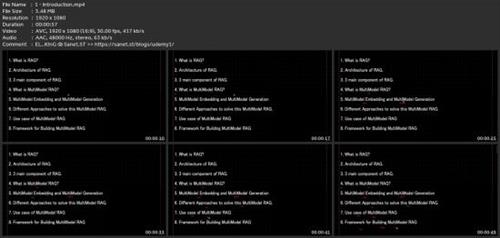- Thread Starter
- #1
Implementing Multi Cloud Modal Data For Beginners

What you'll learn
You are going to learn about Retrieval-Augmented Generation with multimodal data
You are going to build multimodal Retrieval-Augmented Generation systems
You are going to multi multimodal search
You are going to build multi-vector recommended system
Requirements
You need to have internet to take this course
Description
Retrieval-Augmented Generation is a hybrid model that integrates retrieval mechanisms with generative models, enhancing the ability of AI to generate more accurate and contextually relevant text. RAG combines the strengths of information retrieval systems, such as search engines, with the language generation capabilities of models. This approach addresses a common limitation in generative models: the challenge of producing factual and up-to-date information.Retrieval-Augmented Generation overcomes this by introducing a retrieval component that fetches relevant documents from an external corpus, often using dense retrievers such as DPR (Dense Passage Retrieval) or BM25, during the generation process. outputs are produced based on a static dataset on which the model has been trained. While this allows for coherent text generation, these models often struggle with generating factually accurate or domain-specific responses, especially when the required information was not part of their training data. Retrieval-Augmented Generation enhances the performance of generative models by integrating retrieval systems, making it a powerful tool for producing accurate, contextually relevant, and real-time information in various AI-driven applications. One of the significant advantages of Retrieval-Augmented Generation is its flexibility in incorporating external knowledge sources, such as databases, research papers, or updated web articles. This makes it particularly effective for applications requiring real-time, factual information, such as question-answering systems, customer support, or technical documentation.
Overview
Section 1: Introduction
Lecture 1 Introduction
Lecture 2 Multi Model
Lecture 3 Contextual Relationship
Lecture 4 Mango DB Database
Lecture 5 Architecture of Resources in AI
Lecture 6 Multimodel Embedding and Generation
Lecture 7 Types of NoSQL database
Lecture 8 Imagenet
Data Scientists,Machine Learning Engineers

rapidgator.net:
ddownload.com:

Published 9/2024
MP4 | Video: h264, 1920x1080 | Audio: AAC, 44.1 KHz
Language: English | Size: 1.20 GB | Duration: 1h 3m
Learn how to implement multi cloud with modal data and multimodal and Build multi-vector systems more!
MP4 | Video: h264, 1920x1080 | Audio: AAC, 44.1 KHz
Language: English | Size: 1.20 GB | Duration: 1h 3m
Learn how to implement multi cloud with modal data and multimodal and Build multi-vector systems more!
What you'll learn
You are going to learn about Retrieval-Augmented Generation with multimodal data
You are going to build multimodal Retrieval-Augmented Generation systems
You are going to multi multimodal search
You are going to build multi-vector recommended system
Requirements
You need to have internet to take this course
Description
Retrieval-Augmented Generation is a hybrid model that integrates retrieval mechanisms with generative models, enhancing the ability of AI to generate more accurate and contextually relevant text. RAG combines the strengths of information retrieval systems, such as search engines, with the language generation capabilities of models. This approach addresses a common limitation in generative models: the challenge of producing factual and up-to-date information.Retrieval-Augmented Generation overcomes this by introducing a retrieval component that fetches relevant documents from an external corpus, often using dense retrievers such as DPR (Dense Passage Retrieval) or BM25, during the generation process. outputs are produced based on a static dataset on which the model has been trained. While this allows for coherent text generation, these models often struggle with generating factually accurate or domain-specific responses, especially when the required information was not part of their training data. Retrieval-Augmented Generation enhances the performance of generative models by integrating retrieval systems, making it a powerful tool for producing accurate, contextually relevant, and real-time information in various AI-driven applications. One of the significant advantages of Retrieval-Augmented Generation is its flexibility in incorporating external knowledge sources, such as databases, research papers, or updated web articles. This makes it particularly effective for applications requiring real-time, factual information, such as question-answering systems, customer support, or technical documentation.
Overview
Section 1: Introduction
Lecture 1 Introduction
Lecture 2 Multi Model
Lecture 3 Contextual Relationship
Lecture 4 Mango DB Database
Lecture 5 Architecture of Resources in AI
Lecture 6 Multimodel Embedding and Generation
Lecture 7 Types of NoSQL database
Lecture 8 Imagenet
Data Scientists,Machine Learning Engineers
Screenshots

rapidgator.net:
You must reply in thread to view hidden text.
ddownload.com:
You must reply in thread to view hidden text.
